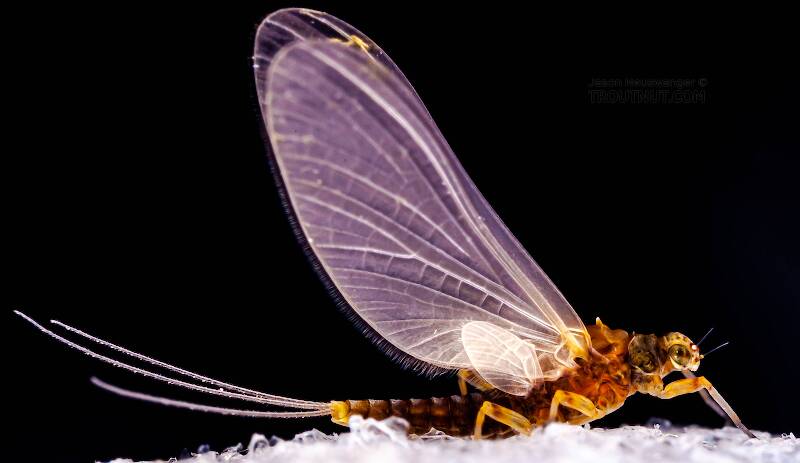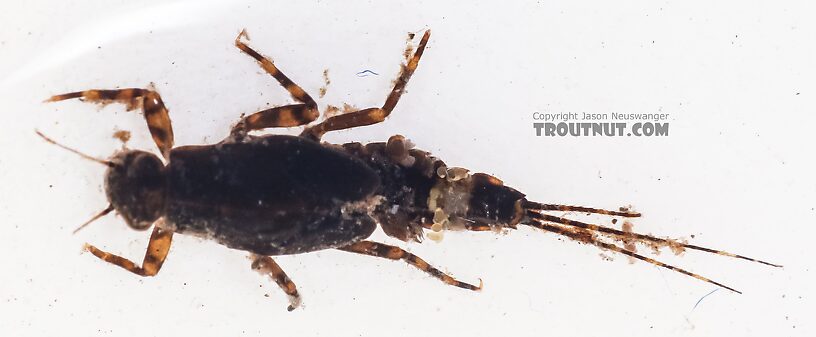
Blue-winged Olives
Baetis
Tiny Baetis mayflies are perhaps the most commonly encountered and imitated by anglers on all American trout streams due to their great abundance, widespread distribution, and trout-friendly emergence habits.


Mayfly Species Attenella margarita (Little Western Blue-Winged Olives)
Species Range
Hatching behavior
Fred Arbona in Mayflies, the Angler, and the Trout says that trout prefer nymphs on the surface when the margaritas are hatching, so a floating nymph is the ideal tactic. He also says this hatch is unusually prone to producing stillborn and crippled duns.However, Knopp and Cormier say that this species, like Attenella attenuata, emerges on the bottom of the stream and rises to the surface as a dun. This conflicts with Arbona's observation.
It may be that the nymphs of this species make several failed trips to the surface, like most in the family Ephemerellidae do, before deciding to emerge, and that Arbona observed feeding during this behavior. Or there may be a wider range of emergence behavior during this hatch than either author realized.
Spinner behavior
Time of day: Late dusk
Nymph biology
Current speed: Slow
Environmental tolerance: Best in consistently cold water
Physical description
Most physical descriptions on Troutnut are direct or slightly edited quotes from the original scientific sources describing or updating the species, although there may be errors in copying them to this website. Such descriptions aren't always definitive, because species often turn out to be more variable than the original describers observed. In some cases, only a single specimen was described! However, they are useful starting points.
Nymph
A species of the simplex (now a synonym of Dannella simplex) group, of which only the nymphal stage is known; dorsal abdominal spines present, but no occipital nor thoracic tubercles.
Head and thorax of nymph smooth. Legs pale; tibiae and tarsi banded at the middle, tarsi also at the tips. 8 to 9 denticles along the inner margin of each claw, the distal one being longest. General color olive brown with blackish markings. Lateral extensions of the abdominal segments are well developed, and terminate in long postero-lateral spines on segments 4 to 9; abdomen broadest at segment 7. Gills present on segments 4 to 7 only, semi-operculate on segment 4. Rather short dorsal spines are present on tergites 3 to 9. Two color phases are known. In the best marked phase, a median blackish spot is present on tergites 2 and 3, and 5 and 6; apical margin of 8 with a black streak; tergite 9 largely blackish except for the lateral extensions and two pale submedian apical dots. Lateral extensions pale, each crossed near the middle by a broad brown band. Brownish ventrally; sternite 8 largely pale yellowish; sternite 9 blackish brown. Tails yellowish white, with a broad black band across the middle and a narrow black band at the tip.
Specimens of the Mayfly Species Attenella margarita
1 Female Dun

1 Nymph

Start a Discussion of Attenella margarita
References
- Arbona, Fred Jr. 1989. Mayflies, the Angler, and the Trout. Nick Lyons Books.
- Caucci, Al and Nastasi, Bob. 2004. Hatches II. The Lyons Press.
- Knopp, Malcolm and Robert Cormier. 1997. Mayflies: An Angler's Study of Trout Water Ephemeroptera . The Lyons Press.
- Needham, James G., Jay R. Traver, and Yin-Chi Hsu. 1935. The Biology of Mayflies. Comstock Publishing Company, Inc.
Mayfly Species Attenella margarita (Little Western Blue-Winged Olives)
Species Range
Resources
- NatureServe
- Integrated Taxonomic Information System
- Global Biodiversity Information Facility
- Described by Needham (1927)

